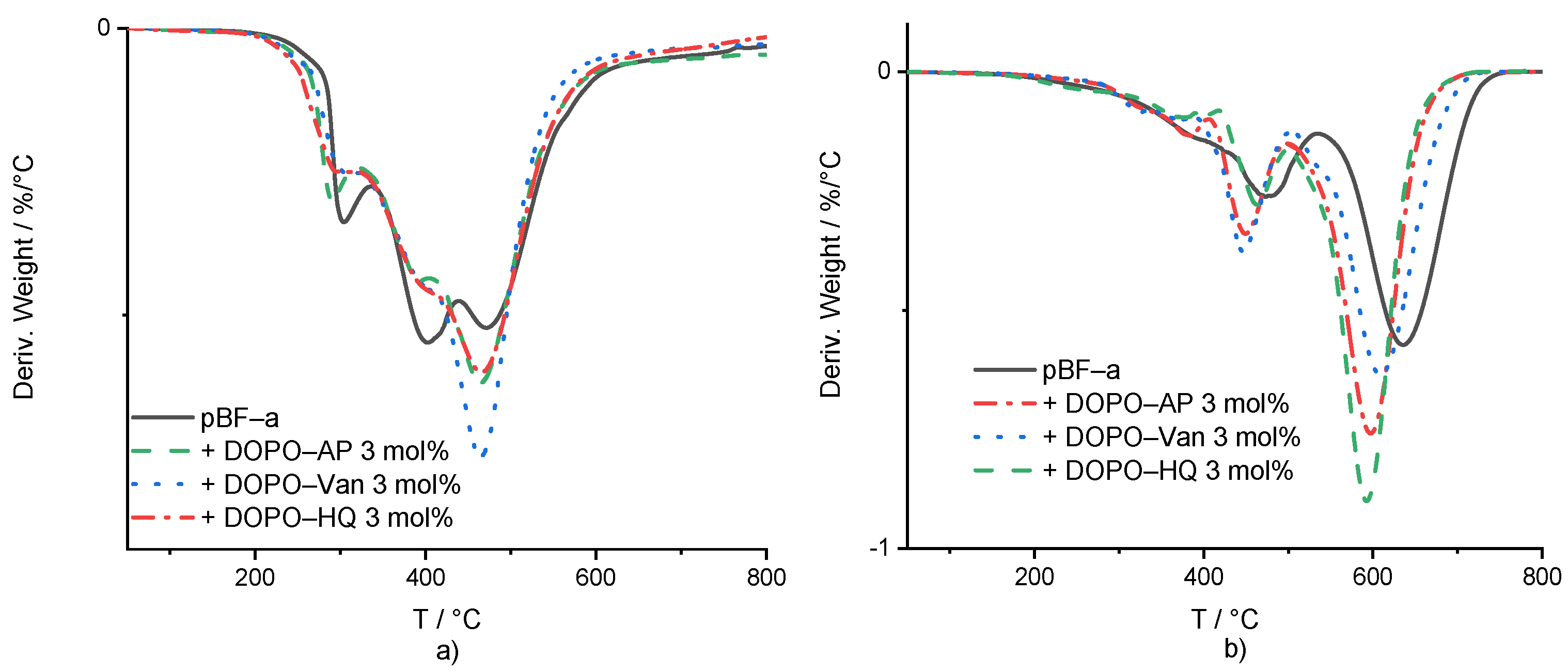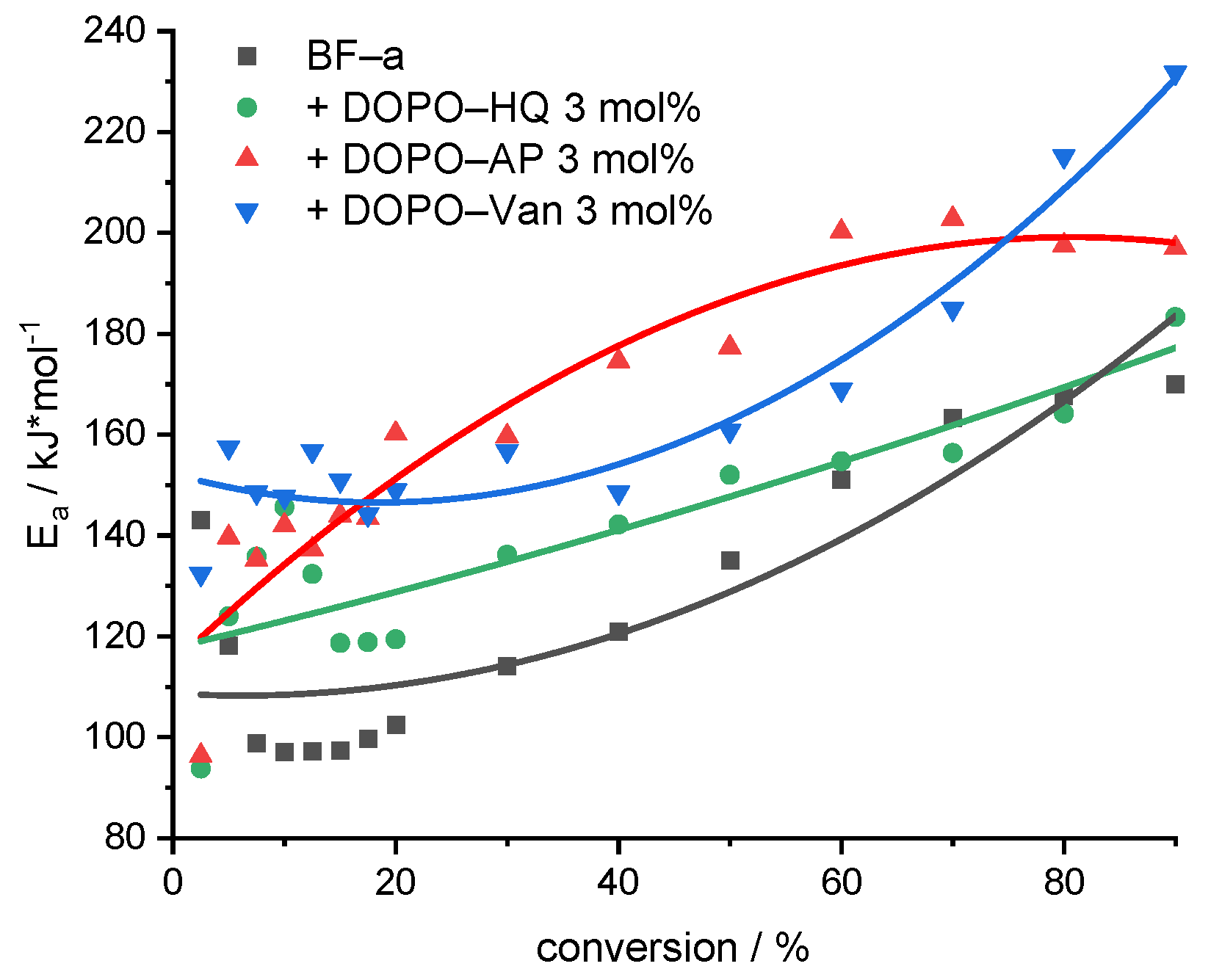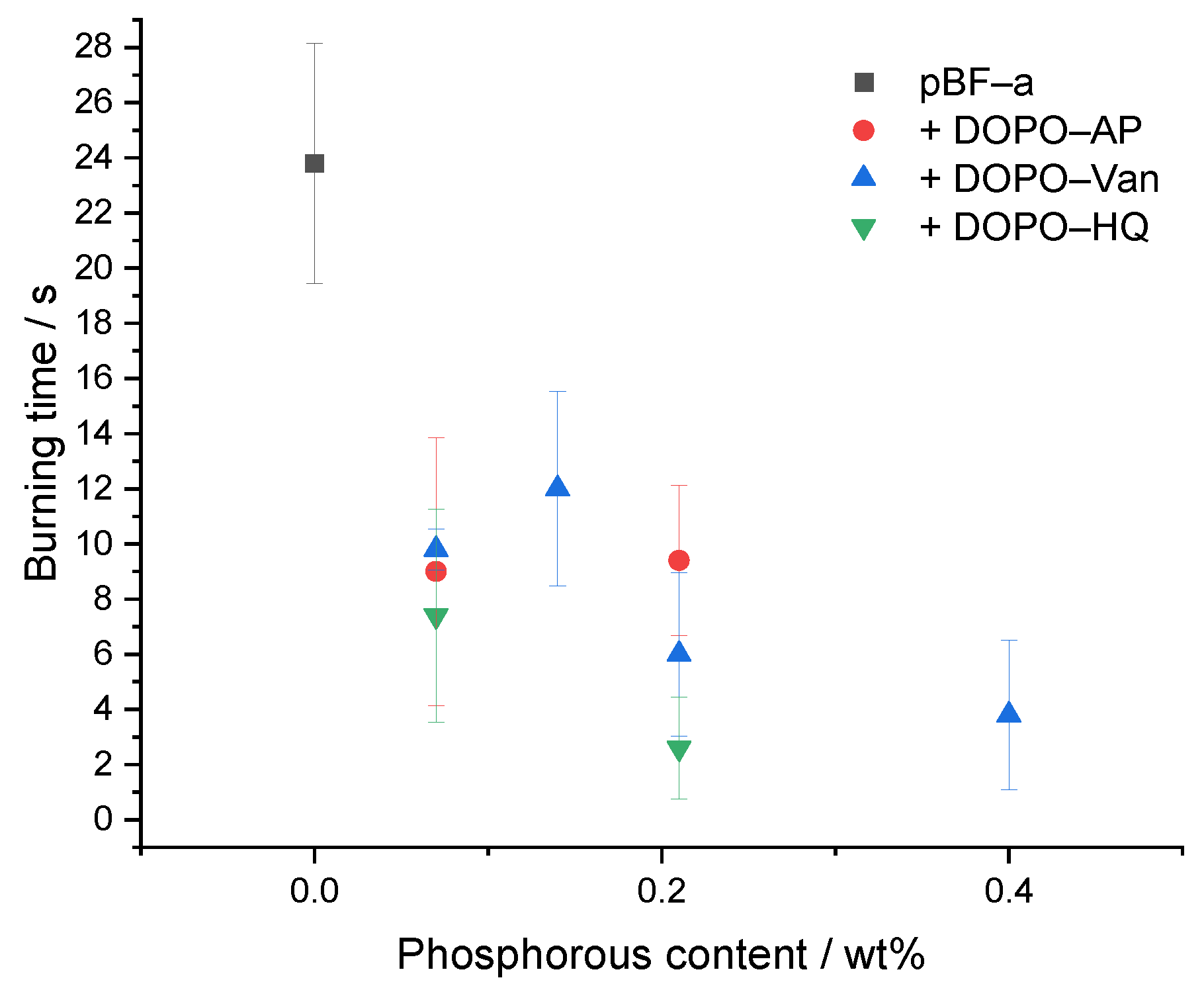Synthesis and Application Studies of DOPO-Based Organophosphorous Derivatives to Modify the Thermal Behavior of Polybenzoxazine
Abstract
:1. Introduction
2. Materials and Methods
2.1. Materials
2.2. Synthesis
2.2.1. Synthesis of 6,6′-(((Methylenebis(4,1-phenylene))bis(azanediyl))bis((4-hydroxy-3-methoxyphenyl)methylene))bis(6H-dibenzo(c,e)(1,2)oxaphosphine 6-oxide (DOPO-Van)
2.2.2. Synthesis of 2-(6-Oxido-6H-dibenz(c,e)(1,2)oxaphosphorin-6-yl)-1,4-hydroxy phenylene (DOPO-HQ)
2.2.3. Synthesis of 4-(2′-Hydroxybenzylidene imino)phenol (1)
2.2.4. Synthesis of 4-((4′-Hydroxyphenylimino)(6-oxido-6h dibenz(c,e)(1,2)oxaphosphorin-6-yl)methyl)phenol (DOPO-AP)
2.3. Sample Preparation and Polymerization Protocol
2.4. Equipment and Characterization
3. Results and Discussion
3.1. Effect on the Polymerization Progress and Thermo-Mechanical Behaviour
3.2. Thermal Stability
3.3. Determining the Reaction against Small Flames
4. Conclusions
Supplementary Materials
Author Contributions
Funding
Institutional Review Board Statement
Informed Consent Statement
Data Availability Statement
Acknowledgments
Conflicts of Interest
References
- Ishida, H.; Allen, D.J.; Ishida, H. Physical and mechanical characterization of near-zero shrinkage polybenzoxazines. J. Polym. Sci. Part B Polym. Phys. 1996, 34, 1019–1030. [Google Scholar] [CrossRef]
- Ishida, H.; Low, H.Y. A Study on the Volumetric Expansion of Benzoxazine-Based Phenolic Resin. Macromolecules 1997, 30, 1099–1106. [Google Scholar] [CrossRef]
- Ghosh, N.; Kiskan, B.; Yagci, Y. Polybenzoxazines—New high performance thermosetting resins: Synthesis and properties. Prog. Polym. Sci. 2007, 32, 1344–1391. [Google Scholar] [CrossRef]
- Liu, C.; Shen, D.; Sebastián, R.M.; Marquet, J.; Schönfeld, R. Mechanistic Studies on Ring-Opening Polymerization of Benzoxazines: A Mechanistically Based Catalyst Design. Macromolecules 2011, 44, 4616–4622. [Google Scholar] [CrossRef]
- Wang, Y.-X.; Ishida, H. Cationic ring-opening polymerization of benzoxazines. Polymer 1999, 40, 4563–4570. [Google Scholar] [CrossRef]
- Schäfer, H.; Hartwig, A.; Koschek, K. The nature of bonding matters: Benzoxazine based shape memory polymers. Polymer 2018, 135, 285–294. [Google Scholar] [CrossRef]
- Sudo, A.; Kudoh, R.; Nakayama, H.; Arima, K.; Endo, T. Selective Formation of Poly(N,O-acetal) by Polymerization of 1,3-Benzoxazine and Its Main Chain Rearrangement. Macromolecules 2008, 41, 9030–9034. [Google Scholar] [CrossRef]
- Dunkers, J.; Ishida, H. Reaction of benzoxazine-based phenolic resins with strong and weak carboxylic acids and phenols as catalysts. J. Polym. Sci. A Polym. Chem. 1999, 37, 1913–1921. [Google Scholar] [CrossRef]
- Andreu, R.; Reina, J.A.; Ronda, J.C. Carboxylic acid-containing benzoxazines as efficient catalysts in the thermal polymerization of benzoxazines. J. Polym. Sci. Part A Polym. Chem. 2008, 46, 6091–6101. [Google Scholar] [CrossRef]
- Ishida, H.; Rodriguez, Y. Catalyzing the curing reaction of a new benzoxazine-based phenolic resin. J. Appl. Polym. Sci. 1995, 58, 1751–1760. [Google Scholar] [CrossRef]
- Hariharan, A.; Srinivasan, K.; Murthy, C.; Alagar, M. Synthesis and characterization of a novel class of low temperature cure Benzoxazines. J. Polym. Res. 2017, 25, 20. [Google Scholar] [CrossRef]
- Kasemsiri, P.; Hiziroglu, S.; Rimdusit, S. Effect of cashew nut shell liquid on gelation, cure kinetics, and thermomechanical properties of benzoxazine resin. Thermochim. Acta 2011, 520, 84–92. [Google Scholar] [CrossRef]
- Hamerton, I.; McNamara, L.T.; Howlin, B.J.; Smith, P.A.; Cross, P.; Ward, S. Examining the Initiation of the Polymerization Mechanism and Network Development in Aromatic Polybenzoxazines. Macromolecules 2013, 46, 5117–5132. [Google Scholar] [CrossRef]
- Wang, J.; Xu, Y.Z.; Fu, Y.F.; Liu, X.D. Latent curing systems stabilized by reaction equilibrium in homogeneous mixtures of benzoxazine and amine. Sci. Rep. 2016, 6, 38584. [Google Scholar] [CrossRef] [PubMed]
- Sun, J.; Wei, W.; Xu, Y.; Qu, J.; Liu, X.; Endo, T. A curing system of benzoxazine with amine: Reactivity, reaction mechanism and material properties. RSC Adv. 2015, 5, 19048–19057. [Google Scholar] [CrossRef]
- Andreu, R.; Espinosa, M.A.; Galià, M.; Cádiz, V.; Ronda, J.C.; Reina, J.A. Synthesis of novel benzoxazines containing glycidyl groups: A study of the crosslinking behavior. J. Polym. Sci. Part A Polym. Chem. 2006, 44, 1529–1540. [Google Scholar] [CrossRef]
- Li, S.; Huang, W.; Liu, X.; Yu, X.; Xiao, W. Synthesis, characterization, and polymerization of brominated benzoxazine monomers and thermal stability/flame retardance of the polymers generated. Polym. Adv. Technol. 2009, 21, 229–234. [Google Scholar] [CrossRef]
- Choi, S.-W.; Ohba, S.; Brunovska, Z.; Hemvichian, K.; Ishida, H. Synthesis, characterization and thermal degradation of functional benzoxazine monomers and polymers containing phenylphosphine oxide. Polym. Degrad. Stab. 2006, 91, 1166–1178. [Google Scholar] [CrossRef]
- Hsieh, C.-Y.; Su, W.-C.; Wu, C.-S.; Lin, L.-K.; Hsu, K.-Y.; Liu, Y.-L. Benzoxazine-containing branched polysiloxanes: Highly efficient reactive-type flame retardants and property enhancement agents for polymers. Polymer 2013, 54, 2945–2951. [Google Scholar] [CrossRef]
- Lin, C.H.; Lin, H.T.; Chang, S.L.; Hwang, H.J.; Hu, Y.M.; Taso, Y.R.; Su, W.C. Benzoxazines with tolyl, p-hydroxyphenyl or p-carboxyphenyl linkage and the structure–property relationship of resulting thermosets. Polymer 2009, 50, 2264–2272. [Google Scholar] [CrossRef]
- Espinosa, M.A.; Cádiz, V.; Galiá, M. Development of novel flame-retardant thermosets based on benzoxazine-phenolic resins and a glycidyl phosphinate. J. Polym. Sci. Part A Polym. Chem. 2003, 42, 279–289. [Google Scholar] [CrossRef]
- Wolter, N.; Beber, V.C.; Haubold, T.; Sandinge, A.; Blomqvist, P.; Goethals, F.; Van Hove, M.; Jubete, E.; Mayer, B.; Koschek, K. Effects of flame-retardant additives on the manufacturing, mechanical, and fire properties of basalt fiber-reinforced polybenzoxazine. Polym. Eng. Sci. 2020, 61, 551–561. [Google Scholar] [CrossRef]
- Li, S.; Yang, C.; Li, C.; Yan, S. Synthesis, characterization of new bisphenol-based benzoxazines and the thermal properties of their polymers. J. Therm. Anal. 2017, 128, 1711–1717. [Google Scholar] [CrossRef]
- Zúñiga, C.; Larrechi, M.S.; Lligadas, G.; Ronda, J.C.; Galià, M.; Cádiz, V. Phosphorus flame retardant polybenzoxazine foams based on renewable diphenolic acid. Polym. Degrad. Stab. 2013, 98, 2617–2626. [Google Scholar] [CrossRef]
- Chang, C.W.; Lin, C.H.; Lin, H.T.; Huang, H.J.; Hwang, K.Y.; Tu, A.P. Development of an aromatic triamine-based flame-retardant benzoxazine and its high-performance copolybenzoxazines. Eur. Polym. J. 2009, 45, 680–689. [Google Scholar] [CrossRef]
- Lin, C.H.; Lin, H.T.; Sie, J.W.; Hwang, K.Y.; Tu, A.P. Facile, one-pot synthesis of aromatic diamine-based phosphinated benzoxazines and their flame-retardant thermosets. J. Polym. Sci. Part A Polym. Chem. 2010, 48, 4555–4566. [Google Scholar] [CrossRef]
- Lin, C.H.; Cai, S.X.; Leu, T.S.; Hwang, T.Y.; Lee, H.H. Synthesis and properties of flame-retardant benzoxazines by three approaches. J. Polym. Sci. Part A Polym. Chem. 2006, 44, 3454–3468. [Google Scholar] [CrossRef]
- Bornosuz, N.V.; Gorbunova, I.Y.; Kireev, V.V.; Bilichenko, Y.V.; Chursova, L.V.; Svistunov, Y.S.; Onuchin, D.V.; Shutov, V.V.; Petrakova, V.V.; Kolenchenko, A.A.; et al. Synthesis and Application of Arylaminophosphazene as a Flame Retardant and Catalyst for the Polymerization of Benzoxazines. Polymers 2021, 13, 263. [Google Scholar] [CrossRef]
- Zhao, L.; Zhao, C.; Guo, C.; Li, Y.; Li, S.; Sun, L.; Li, H.; Xiang, D. Polybenzoxazine Resins with Polyphosphazene Microspheres: Synthesis, Flame Retardancy, Mechanisms, and Applications. ACS Omega 2019, 4, 20275–20284. [Google Scholar] [CrossRef]
- Xiao, Y.; Li, L.; Cai, H.; Liu, F.; Zhang, S.; Feng, J.; Jiang, Y.; Feng, J. In situ co-polymerization of high-performance polybenzoxazine/silica aerogels for flame-retardancy and thermal insulation. J. Appl. Polym. Sci. 2020, 138, 50333. [Google Scholar] [CrossRef]
- Taylor, M.; Cavalli, G.; Hamerton, I. Examining the Influence of Organophosphorus Flame Retardants on the Thermal Behavior of Aromatic Polybenzoxazines. Macromol. Chem. Phys. 2018, 220, 1800282. [Google Scholar] [CrossRef]
- Ciesielski, M.; Diederichs, J.; Döring, M.; Schäfer, A. (Eds.) Fire and Polymers V: Advanced Flame-Retardant Epoxy Resins for Composite Materials. In Advanced Flame-Retardant Epoxy Resins for Composite Materials; Oxford University Press: Oxford, UK, 2009. [Google Scholar]
- Wang, C.S.; Lin, C.H.; Chen, C.Y. Synthesis and properties of phosphorus-containing polyesters derived from 2-(6-oxido-6H-dibenz[c,e][1,2]oxaphosphorin-6-yl)-1,4- hydroxyethoxy phenylene. J. Polym. Sci. A Polym. Chem. 1998, 36, 3051–3061. [Google Scholar] [CrossRef]
- Ho, T.-H.; Hwang, H.-J.; Shieh, J.-Y.; Chung, M.-C. Thermal, physical and flame-retardant properties of phosphorus-containing epoxy cured with cyanate ester. React. Funct. Polym. 2009, 69, 176–182. [Google Scholar] [CrossRef]
- Gu, L.; Qiu, J.; Sakai, E. A novel DOPO-containing flame retardant for epoxy resin. High Perform. Polym. 2016, 29, 899–912. [Google Scholar] [CrossRef]
- Lin, C.H.; Hwang, T.Y.; Taso, Y.R.; Lin, T.L. Phosphorus-Containing Epoxy Curing Agents via Imine Linkage. Macromol. Chem. Phys. 2007, 208, 2628–2641. [Google Scholar] [CrossRef]
- Xiong, Y.-Q.; Zhang, X.-Y.; Liu, J.; Li, M.-M.; Guo, F.; Xia, X.-N.; Xu, W.-J. Synthesis of novel phosphorus-containing epoxy hardeners and thermal stability and flame-retardant properties of cured products. J. Appl. Polym. Sci. 2012, 125, 1219–1225. [Google Scholar] [CrossRef]
- Pospiech, D.; Korwitz, A.; Komber, H.; Jehnichen, D.; Häußler, L.; Scheibner, H.; Liebmann, M.; Jähnichen, K.; Voit, B. Biobased Aliphatic Polyesters with DOPO Substituents for Enhanced Flame Retardancy. Macromol. Chem. Phys. 2015, 216, 1447–1461. [Google Scholar] [CrossRef]
- Tehan, B.G.; Lloyd, E.J.; Wong, M.G.; Pitt, W.R.; Montana, J.G.; Manallack, D.T.; Gancia, E. Estimation of pKa Using Semiempirical Molecular Orbital Methods. Part 1: Application to Phenols and Carboxylic Acids. Quant. Struct.-Act. Relat. 2002, 21, 457–472. [Google Scholar] [CrossRef]
- Pearce, P.J.; Simkins, R.J.J. Acid strengths of some substituted picric acids. Can. J. Chem. 1968, 46, 241–248. [Google Scholar] [CrossRef]
- Andreu, R.; Reina, J.A.; Ronda, J.C. Studies on the thermal polymerization of substituted benzoxazine monomers: Electronic effects. J. Polym. Sci. Part A Polym. Chem. 2008, 46, 3353–3366. [Google Scholar] [CrossRef]
- Ohashi, S.; Iguchi, D.; Heyl, T.R.; Froimowicz, P.; Ishida, H. Quantitative studies on the p-substituent effect of the phenolic component on the polymerization of benzoxazines. Polym. Chem. 2018, 9, 4194–4204. [Google Scholar] [CrossRef]
- Lyu, Y.; Rachita, E.; Pogharian, N.; Froimowicz, P.; Ishida, H. Electronic effects of asymmetric and meta-alkoxy substituents on the polymerization behavior of bis-benzoxazines. Polym. Chem. 2019, 11, 800–809. [Google Scholar] [CrossRef]
- Hamerton, I.; Thompson, S.; Howlin, B.J.; Stone, C.A. New Method To Predict the Thermal Degradation Behavior of Polybenzoxazines from Empirical Data Using Structure Property Relationships. Macromolecules 2013, 46, 7605–7615. [Google Scholar] [CrossRef]
- Ishida, H.; Sanders, D.P. Improved thermal and mechanical properties of polybenzoxazines based on alkyl-substituted aromatic amines. J. Polym. Sci. Part B Polym. Phys. 2000, 38, 3289–3301. [Google Scholar] [CrossRef]
- Hemvichian, K.; Ishida, H. Thermal decomposition processes in aromatic amine-based polybenzoxazines investigated by TGA and GC–MS. Polymer 2002, 43, 4391–4402. [Google Scholar] [CrossRef]
- Flynn, J.H.; Wall, L.A. General treatment of the thermogravimetry of polymers. J. Res. Natl. Bur. Stand. Sect. A Phys. Chem. 1966, 70A, 487–523. [Google Scholar] [CrossRef]
- Li, Y.; Qiang, Z.; Chen, X.; Ren, J. Understanding thermal decomposition kinetics of flame-retardant thermoset polylactic acid. RSC Adv. 2019, 9, 3128–3139. [Google Scholar] [CrossRef] [Green Version]







| Sample (Composition) | Quantity [mol%] | aT1st [°C] | b T2nd [°C] | c T3rd [°C] | d Yc [%] |
|---|---|---|---|---|---|
| pBF-a | 304 | 401 | 472 | 44 | |
| + DOPO-AP | 1 | 302 | 401 | 468 | 47 |
| + DOPO-AP | 3 | 305 | 399 | 467 | 46 |
| + DOPO-Van | 0.5 | 298 | 401 | 473 | 43 |
| + DOPO-Van | 1 | 287 | 398 | 472 | 50 |
| + DOPO-Van | 1.5 | 288 | 403 | 467 | 43 |
| + DOPO-Van | 3 | 303 | 401 | 464 | 46 |
| + DOPO-HQ | 1 | 295 | 397 | 464 | 44 |
| + DOPO-HQ | 3 | 292 | 394 | 468 | 45 |
| Additive | Quantity [mol%] | a Pwt% | Total Burning Time [s] | UL-94 Grade | LOI [%] |
|---|---|---|---|---|---|
| pBF-a | 0 | 23.8 4.4 | V-1 | 26.1 0.2 | |
| DOPO-AP | 1 | 0.07 | 9.0 4.9 | V-0 | 27.0 0.3 |
| DOPO-AP | 3 | 0.21 | 9.4 2.7 | V-0 | 28.3 0.3 |
| DOPO-Van | 0.5 | 0.07 | 9.8 0.7 | V-0 | 27.0 0.2 |
| DOPO-Van | 1 | 0.14 | 12 3.5 | V-1 | 28.0 0.3 |
| DOPO-Van | 1.5 | 0.21 | 6.0 3.0 | V-0 | 28.5 0.2 |
| DOPO-Van | 3 | 0.4 | 3.8 2.7 | V-0 | 28.1 0.2 |
| DOPO-HQ | 1 | 0.07 | 7.4 3.8 | V-0 | 28.3 0.2 |
| DOPO-HQ | 3 | 0.21 | 2.6 1.9 | V-0 | 28.3 0.2 |
Publisher’s Note: MDPI stays neutral with regard to jurisdictional claims in published maps and institutional affiliations. |
© 2022 by the authors. Licensee MDPI, Basel, Switzerland. This article is an open access article distributed under the terms and conditions of the Creative Commons Attribution (CC BY) license (https://creativecommons.org/licenses/by/4.0/).
Share and Cite
Haubold, T.S.; Hartwig, A.; Koschek, K. Synthesis and Application Studies of DOPO-Based Organophosphorous Derivatives to Modify the Thermal Behavior of Polybenzoxazine. Polymers 2022, 14, 606. https://doi.org/10.3390/polym14030606
Haubold TS, Hartwig A, Koschek K. Synthesis and Application Studies of DOPO-Based Organophosphorous Derivatives to Modify the Thermal Behavior of Polybenzoxazine. Polymers. 2022; 14(3):606. https://doi.org/10.3390/polym14030606
Chicago/Turabian StyleHaubold, Thorben Sören, Andreas Hartwig, and Katharina Koschek. 2022. "Synthesis and Application Studies of DOPO-Based Organophosphorous Derivatives to Modify the Thermal Behavior of Polybenzoxazine" Polymers 14, no. 3: 606. https://doi.org/10.3390/polym14030606






